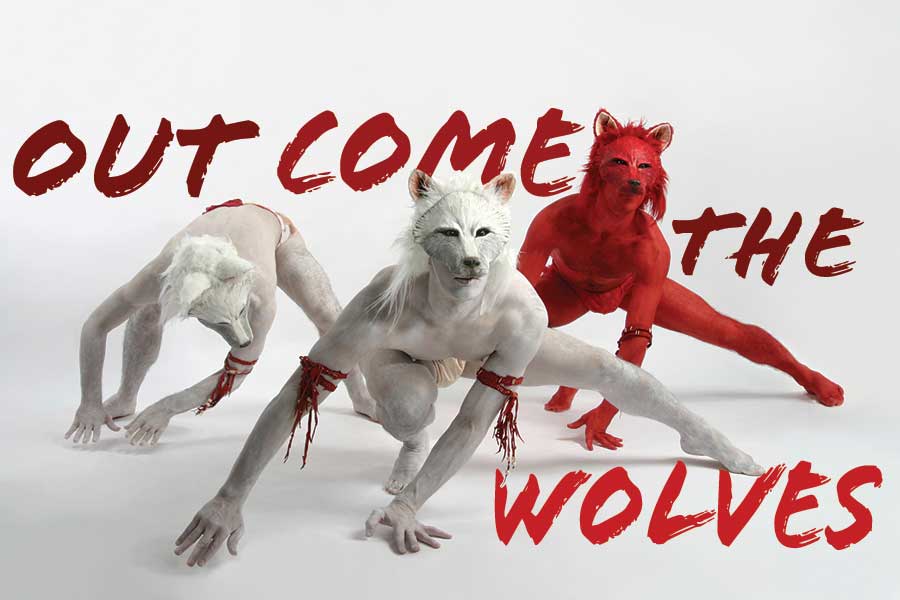Local theatergoers have a chance to witness an original dance opera in progress when Philadelphia Dance Projects and American Opera Projects present “Wolf-in-Skins” Nov. 29-30 at The Kimmel Center.
Created by out choreographer Christopher Williams and composer Gregory Spears, the production brings a menagerie of kings, wolves, hounds, faeries and other fantastical characters to the stage in a dance opera that draws inspiration from Welsh, pre-Celtic and pre-Christian mythology.
Williams said “Wolf-in-Skins” is a work in progress. The team staged most of the first act in 2013 and is bringing some of those scenes back, along with new scenes from the second act.
Audiences will also get to see some of the striking visuals, and costumes will make it into the completed production.
“The designs for the work were generated with my longtime collaborator Andrew Jordan,” Williams said. “We’ll be using the costumes for select characters from the piece in their full form for this presentation. What we won’t have is the theatrical lighting and the proscenium theater that it ultimately requires, so it will be an opportunity for audiences to experience excerpts from the piece quite intimately. Excerpts from scenes in the work’s first act along with a new aria from the second act for countertenor Anthony Roth Costanzo will be performed, along with a few musical selections performed in concert style by opera singers and the period-instrument ensemble New Vintage Baroque.”
Influences of Celtic, medieval and pre-Christian mythology have trickled into pop culture in many different ways, shapes and forms over the years.
However, Williams said, the source material for “Wolf-in-Skins” comes from stories and material with which most people won’t be familiar, such as obscure medieval Welsh texts “The Red Book of Hergest” and “The White Book of Rhydderch.”
“Inspiration for this work comes from a bunch of medieval Welsh tales collectively known as the Mabinogi. It’s among the earliest Brythonic literature we know of,” he explained. “The tales’ true origin is obscured because they were compiled from the 13th-14th centuries and had already been glossed with themes common in chivalric romances of the time. But the tales themselves most likely derive from much more ancient Celtic and even pre-Celtic mythology. So you see characters that have cognates across the various Insular Celtic traditions. There are many characters in Welsh mythology that clearly derive from the same sources as characters from Irish myths with identical attributes, for example. The tales themselves and the mythology behind them are so ancient and fragmentary, so we don’t know much about them. We do know about their local expression in Welsh culture because they were preserved in these medieval texts and they have actually influenced a lot of things that are familiar to us. They are very closely linked with the Arthurian legend, for example, although I’m not treating the Arthur and Merlin tale. They represent another branch of the same mythic root. It’s a larger mythic system that not too many people are familiar with, and that is a big part of what draws me to it.”
Williams also wanted to incorporate a modern twist to the story by having a same-sex romance between two of the characters.
“I’m a firm believer that mythology has to be retold and has to evolve along with culture in order to remain pertinent to our lives,” he said. “Anything that doesn’t evolve and change along with us risks becoming stagnant and dated in a way that makes it harder for many people to relate to it. So one of my interests is to look at ancient material and explore how it might be made relevant to us today from my point of view as a contemporary queer artist.”
Towards that aim, Williams made one of the original female characters a male.
“I’ve borrowed elements from the ancient tales and have loosely based my libretto on scenarios drawn from them. I have switched the gender of one of the prime players in my story so that a situation of romantic desire occurs between two male characters. I wanted to feature the age of mythology among the many queer narratives that are at last entering mainstream culture today.”
Williams — who is classically trained in dance and studied at the Cunningham Studio — noted that “Wolf-in-Skins” takes the choreography into some interesting and innovative directions.
“My dance background comes from a pretty formal training. My personal style includes some elements of Merce Cunningham’s technique, which I studied for many years, but I also like to feature the use of the head and extra use of the torso, particularly in spiral motion,” he noted. “You will see that this piece relies heavily on movement, as all characters are choreographed, including the singers. The movement for the singers isn’t as highly technical as that of the dancers because they have to sing as well as dance, but the whole thing is truly a work of choreography. Each genre of character has its own stylistic conventions intended to bring out the qualities of its species. For example, all the human characters in the work are played by opera singers. All the supernatural characters (or faerie folk) are played by dancers. The bestial characters are often represented by puppets. Each being in the work’s magical storybook world has its own expression through movement.”
Philadelphia Dance Projects presents “Wolf-in-Skins” Nov. 29-30 at the Kimmel Center’s SEI Innovation Studio, 300 S. Broad St. For more information or tickets, call 215-893-1999 or visit www.philadanceprojects.org or www.christopherwilliamsdance.org.
